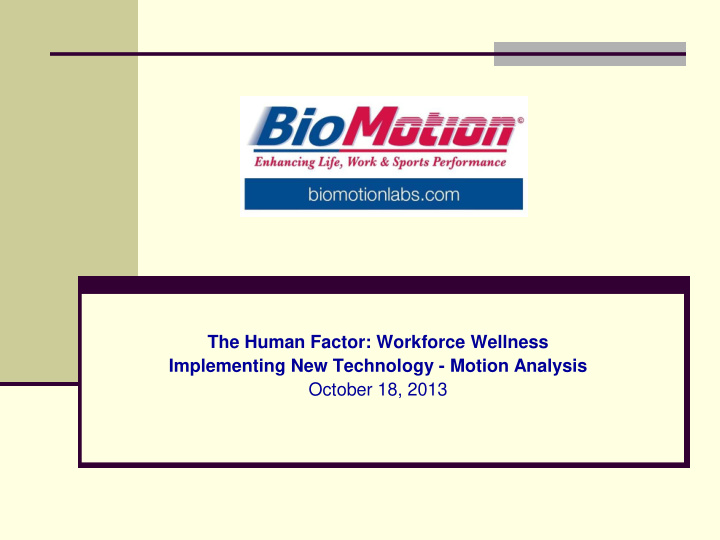



The Human Factor: Workforce Wellness Implementing New Technology - Motion Analysis October 18, 2013
Barrier to Healthy Workforce: Chronic & Unresolved Musculoskeletal Pain The Statistics are Staggering: 100 million report daily chronic pain 44 million report low back pain Back pain affects 8 out of 10 at some point during their lives (NIH) The Costs are Unsustainable : $950 billion – annual direct & indirect costs for musculoskeletal-related healthcare (2004-2006) Employer impact : Back pain caused 385 million lost work days in 2008 Musculoskeletal disorders for work-related injuries = ½ of days away from work Increasing medical & indemnity costs, loss of productivity, overtime & competitiveness 1. The Burden of Musculoskeletal Diseases in the United States, www.boneandjointburden.org/ 2. AAPM Facts and Figures on Pain, www.painmed.org/patient/facts.html#overview
The Challenge: Complexity of Injuries & Disorders Every day, millions of people visit doctors and physical/occupational therapists seeking relief from musculoskeletal injuries and disorders causing pain & limiting life, work or sports activities. At the root of this challenge: Difficulty assessing movement related injuries/disorders by visual observation & standard (static) diagnostic imaging To provide a perspective - the human body has 206 bones connected to 640 skeletal muscles activated and controlled by thousands of motor and sensory nerves all expected to work in intricate 3-dimensional patterns while maintaining stability under external forces and responding immediately to feedback from our eyes, ears and touch A simple functional activity such as walking is quite complex When this process breaks down & does not respond to conservative treatment, clinicians need access to clear, objective and relevant functional information to determine movement strategies or compensation patterns not observable
Current Status & Solutions Pre-Injury Limited employer investment in wellness programs, job analysis & define/adopt early RTW options Post-offer/pre-employment screening; establish date of hire physical/functional baseline Post-Injury Use of established treatment guidelines Outliers – patients in delayed recovery Use of Static Imaging...such as MRI, produce snapshots of underlying anatomy – no functional data relating to motion during activities that may be producing pain, impacting successful treatment Accurate, objective conclusions relating to dynamic physical abilities cannot be drawn from static MRI images any more than one could describe how a person walks, runs or moves by simply looking at a photograph
New Technology Solution: Motion Analysis, Biomechanics
New Technology Solution: Motion Analysis, Biomechanics 3-D motion capture measures a broad range of whole-body movement characteristics : To provide greater insight into root causes of musculoskeletal injuries and disorders, enhancing physicians diagnosis determination and appropriate treatment plans Identification and understanding of underlying root causes of pain or dysfunction as well as movement compensation strategies Evaluate to determine physical ability -postural & strength demands for post-offer/pre-employment job placement, fitness for duty and safe return to work
Thank You!
Recommend
More recommend